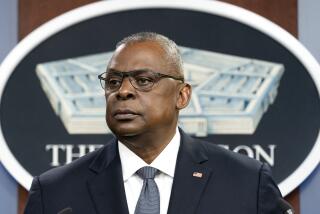More C-17 Orders Could Give Boeing a Lift
- Share via
The outlook for 8,000 Boeing Co. employees who assemble the C-17 military transport in Long Beach brightened Friday when a top Air Force official said the Pentagon’s review of its future needs will probably recommend building more than the 120 C-17s already on order.
“We’re looking forward to it actually happening,” said Boeing spokesman George Sillia in Long Beach, noting that “we’ve been saying for years” that the Defense Department requires more of the “airlifters.” But he cautioned that the Pentagon has not made a final decision.
Separately, Boeing sent shudders through the Seattle area for a second time this week, saying it will move production of fuselages for its 757 commercial jetliner to Wichita, Kan., from Renton, Wash. Boeing already builds fuselages for its popular 737 jet in Wichita.
About 500 Renton workers will be affected by the change, and Boeing said it will try to find work for them elsewhere in the company. But the move, coming on the heels of Wednesday’s announcement that Boeing plans to move its headquarters out of Seattle, rekindled fears that Boeing might shift additional commercial airplane work from its base in Washington.
Darleen Druyun, the Air Force’s top acquisition official, said, “We need to buy some more C-17s--I can’t tell you how many, and we’ll know that not later than August, from what I am told.”
The money for additional C-17s would show up first in the fiscal 2003 budget, she said in an interview with Bloomberg News. Coincidentally, Boeing--which inherited the program when it bought McDonnell Douglas Corp. in 1997--delivered its 72nd C-17 to the Air Force on Friday.
“They are looking at the real airlift requirements and how do you satisfy them, the size of the defense budget and what can you afford,” Druyun said of the various task forces that contribute to the Pentagon’s review.
An industry analyst also said prospects are good for building more of the planes. “The C-17 is the only new long-range transport aircraft the Air Force has, so it’s a safe bet if the review is going to emphasize long-range, global mobility, the C-17 is likely to benefit,” said Loren Thompson, chief operating officer of the Lexington Institute, a research firm in Arlington, Va.
However, it’s important that the Pentagon decide sooner rather than later about ordering more C-17s, because Boeing needs to line up additional agreements with its suppliers well in advance of assembling more of the planes, said Boeing’s Sillia.
“It’s somewhat urgent that these decisions be made,” he said, adding that current C-17 production is slated to end in 2004.
The transfer of fuselage work on Boeing’s 757 stems from the company’s sweeping review of its manufacturing needs in the face of fierce competition from rival Airbus Industrie of Europe and prospects for slowing growth in demand for jetliners.
Although jetliners accounted for as much as 85% of Boeing’s business in the past, it’s now about 60%, with 25% coming from military aircraft and other defense gear and 15% from its Space & Communications Group based in Seal Beach, said Alan Mulally, chief executive of Boeing’s commercial airplane unit.
But Friday’s announcement “is clearly a signal that our fundamental strategy for commercial airplanes is going to be led out of Puget Sound and Seattle,” Mulally told a news conference in Seattle. “I don’t anticipate a lot of major relocation.”
He and other Boeing officials made no specific comments about potential factory-use changes at their defense and space operations, which are concentrated heavily in Southern California.
Times staff writer Kim Murphy in Seattle contributed to this report.
More to Read
Inside the business of entertainment
The Wide Shot brings you news, analysis and insights on everything from streaming wars to production — and what it all means for the future.
You may occasionally receive promotional content from the Los Angeles Times.










